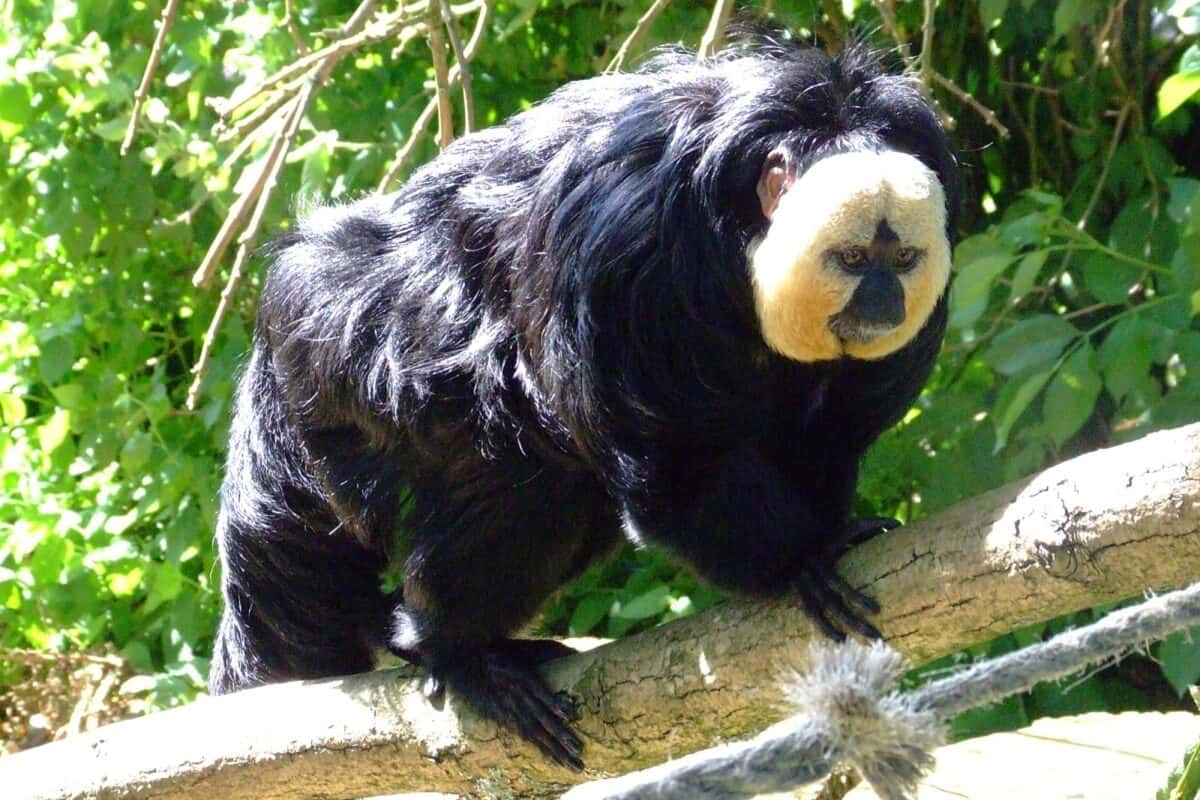Deep within the misty mountain forests of Southeast Asia dwells a primate whose appearance might seem more fitting for Halloween than for a nature documentary. With gleaming white canines that protrude dramatically from its upper jaw, the aptly nicknamed “vampire monkey” presents a startling sight to those lucky enough to spot one in the wild. Yet despite its fearsome dental display, this remarkable creature—scientifically known as Presbytis femoralis—is a peaceful leaf-eater with a fascinating evolutionary story. The draculin monkey, as it’s sometimes called, offers a compelling example of how evolution can produce seemingly alarming features that serve surprisingly practical purposes in nature’s complex web. Let’s explore the world of this unique primate whose fascinating fangs have captured the imagination of scientists and nature enthusiasts alike.
The Dracula Monkey: Introduction to the Species
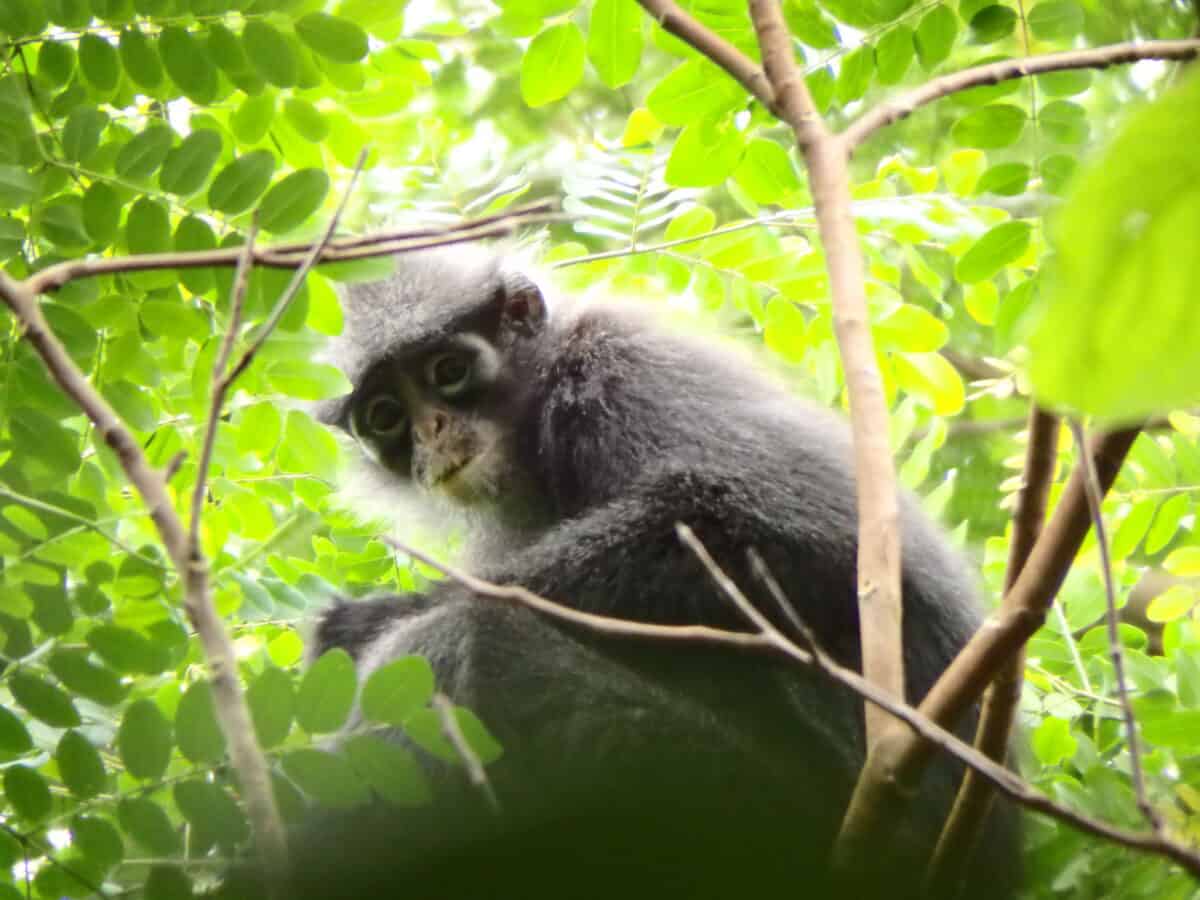
Despite its vampire-like nickname, the monkey with prominent fangs is a langur—specifically, the banded leaf monkey (Presbytis femoralis) or in some discussions, the closely related white-faced saki (Pithecia pithecia). Both belong to the Old World monkey family and inhabit specific regions of Southeast Asia and South America respectively. These medium-sized primates typically weigh between 9-20 pounds, with males being larger than females. Their most distinctive feature—the prominent canine teeth that resemble vampire fangs—has made them internet sensations whenever photos circulate online. While their appearance might suggest carnivorous habits, these monkeys are primarily folivores (leaf-eaters) and frugivores (fruit-eaters), using their impressive dental equipment for purposes entirely different from what their nickname might suggest.
Evolutionary Purpose of the Impressive Fangs
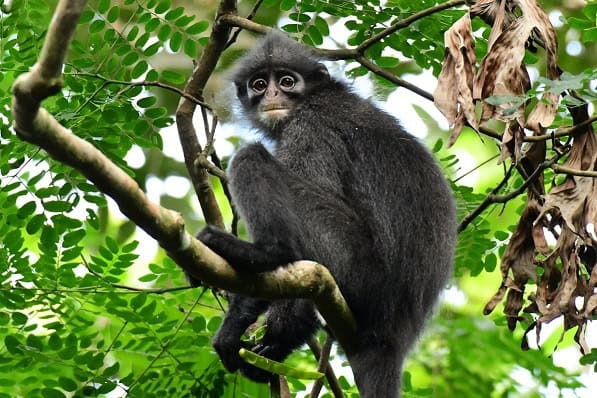
The striking canine teeth of these primates represent a classic example of evolutionary adaptation, though not for the reasons one might initially assume. Unlike vampire bats that use their sharp teeth to pierce skin and consume blood, these monkeys’ impressive canines serve multiple non-predatory functions. First and foremost, they act as powerful tools for processing tough plant materials, allowing the monkeys to tear through fibrous vegetation and hard fruit rinds. Perhaps more importantly, the enlarged canines play a crucial role in social dynamics and sexual selection. Male langurs and sakis display their impressive teeth during dominance interactions and territorial disputes, using them as visual signals rather than weapons. This sexual dimorphism—where males typically have larger canines than females—underscores their role in mate competition and social hierarchies rather than predation.
Habitat and Geographic Distribution
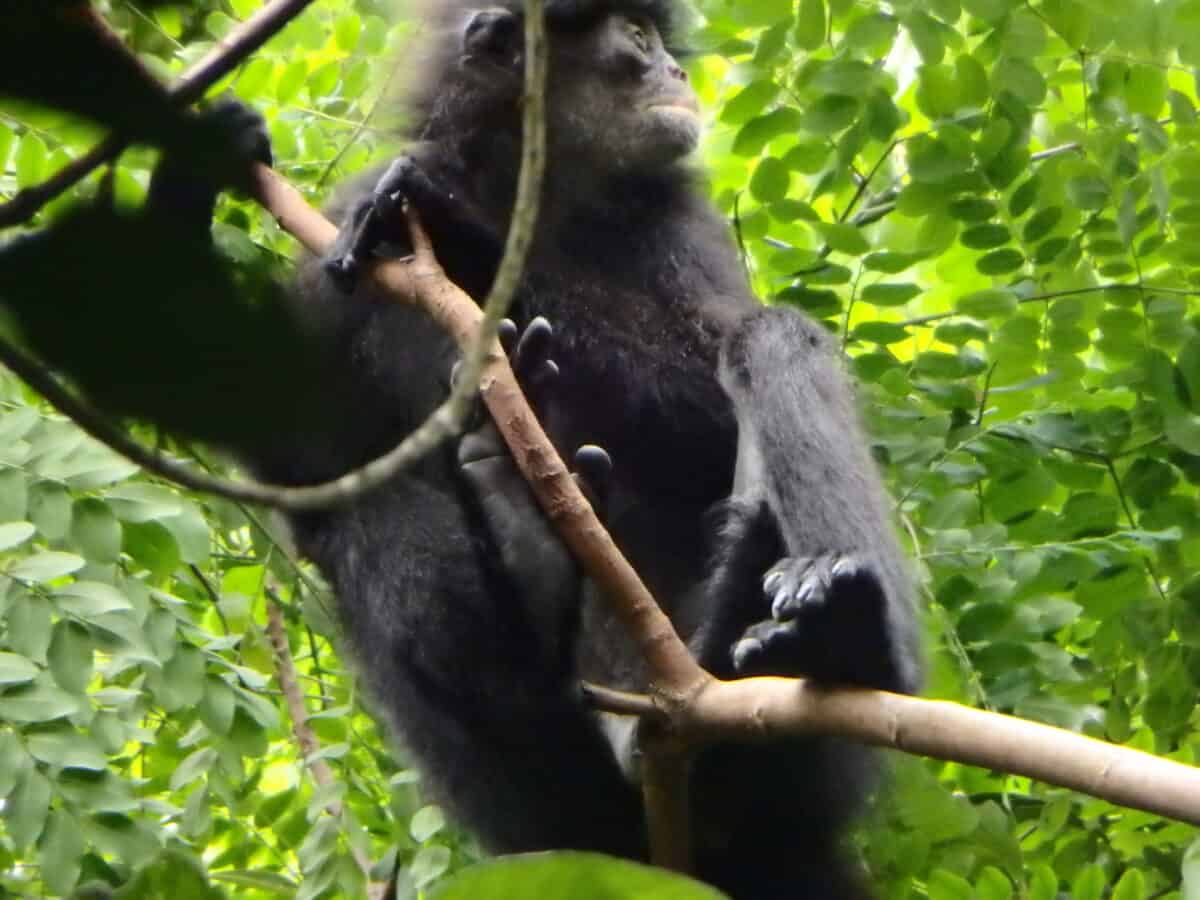
The vampiric-looking primates inhabit specific ecological niches across different continents. The banded leaf monkey is native to the tropical rainforests of Malaysia, Singapore, and parts of Indonesia. These primates prefer dense, undisturbed forests with mature trees that provide both food resources and protection from predators. Their highly specialized diet requires specific forest types that offer the young leaves, fruits, and seeds they depend on. Meanwhile, the white-faced saki monkey with similarly impressive canines dwells in the northern regions of South America, primarily in the Amazon Basin. Both species face significant habitat challenges due to deforestation and human encroachment, with some populations now restricted to isolated forest fragments. The Singapore population of banded leaf monkeys, for instance, is critically endangered, with only a few hundred individuals remaining in the Central Catchment Nature Reserve.
Diet and Feeding Habits
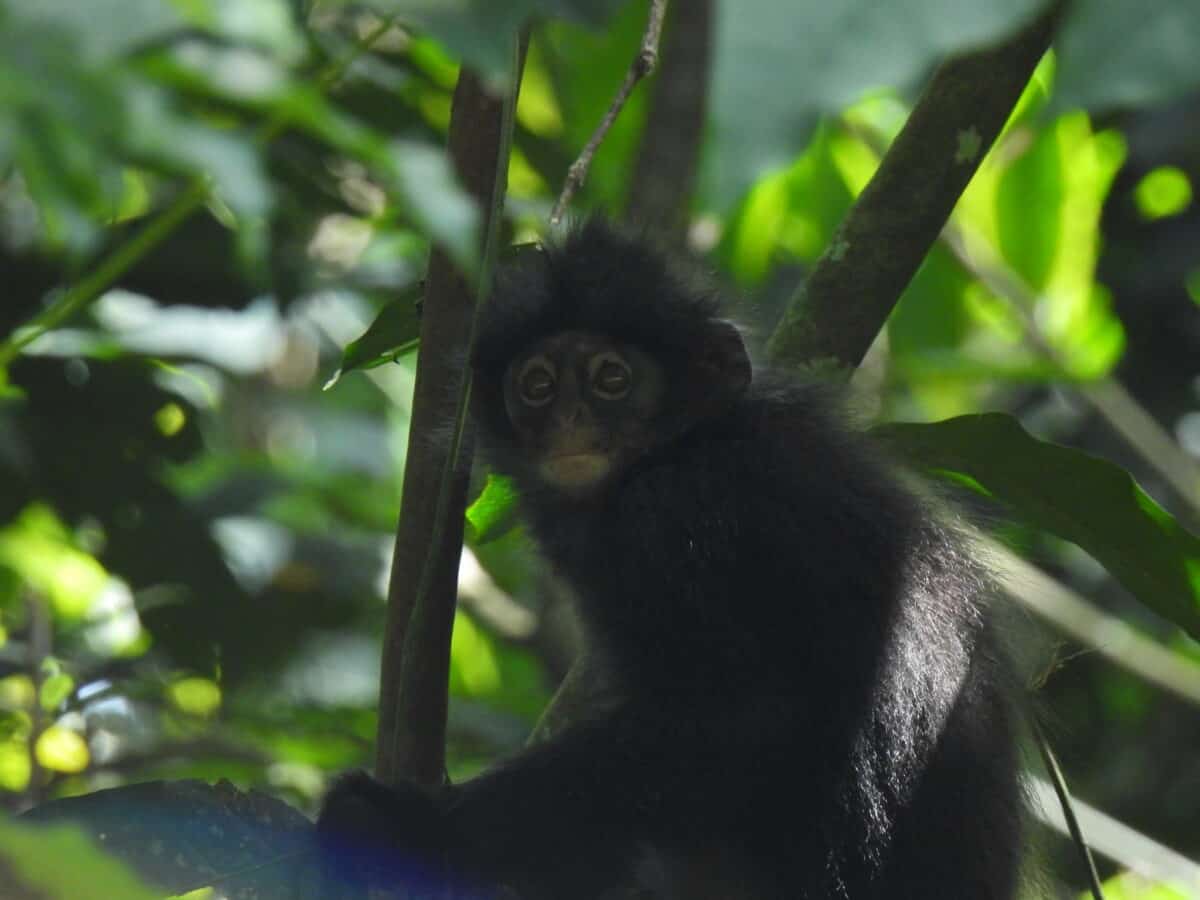
Contrary to what their vampire-like appearance might suggest, these fanged primates maintain a strictly plant-based diet. Banded leaf monkeys are specialized folivores, with young leaves constituting approximately 60-80% of their diet. Their digestive systems have evolved sophisticated adaptations for breaking down cellulose and neutralizing plant toxins. When available, they supplement their leaf consumption with unripe fruits, flowers, and seeds. The monkeys’ impressive canine teeth help them access these food resources by tearing through tough plant fibers and cracking hard seed casings. Their feeding patterns typically show two peak activity periods—early morning and late afternoon—when they actively forage in the forest canopy. Researchers have observed that these monkeys are selective feeders, often preferring young leaves from specific tree species that offer higher nutritional content and fewer defensive compounds.
Social Structure and Behavior
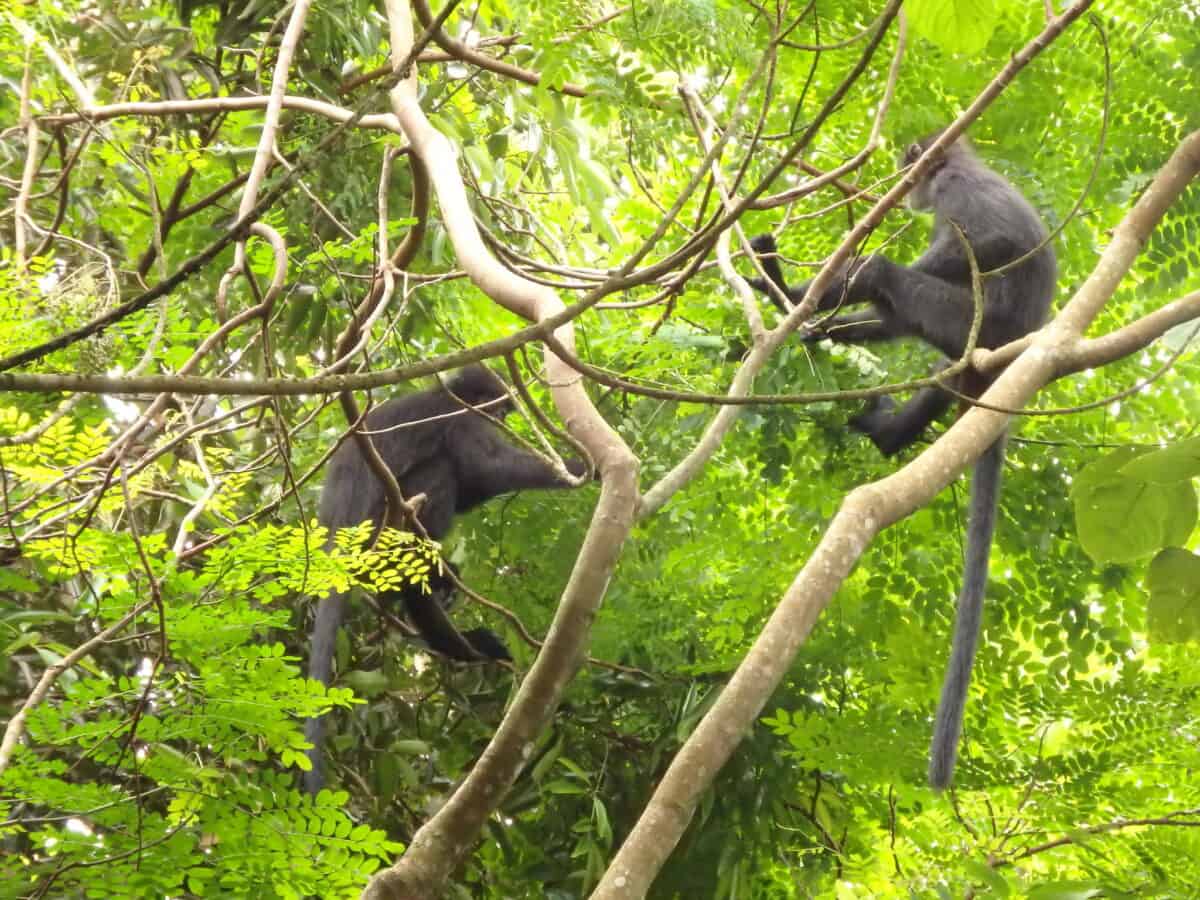
The social organization of these fanged primates reveals complex dynamics that belie their fearsome appearance. Banded leaf monkeys typically live in groups ranging from 10-20 individuals, though group size varies by habitat quality and population density. These groups usually consist of a dominant adult male, several females, and their offspring—a structure known as a one-male, multi-female group or harem. The impressive canine display comes into play during male competitions for group leadership, where males may bare their teeth in threat displays without necessarily engaging in physical combat. Interestingly, in some populations, researchers have observed multiple-male groups forming in response to predation pressure or resource availability. Vocal communication plays a crucial role in maintaining group cohesion, with distinct calls for alarm, territorial defense, and group coordination during movement through the forest canopy.
Reproduction and Life Cycle
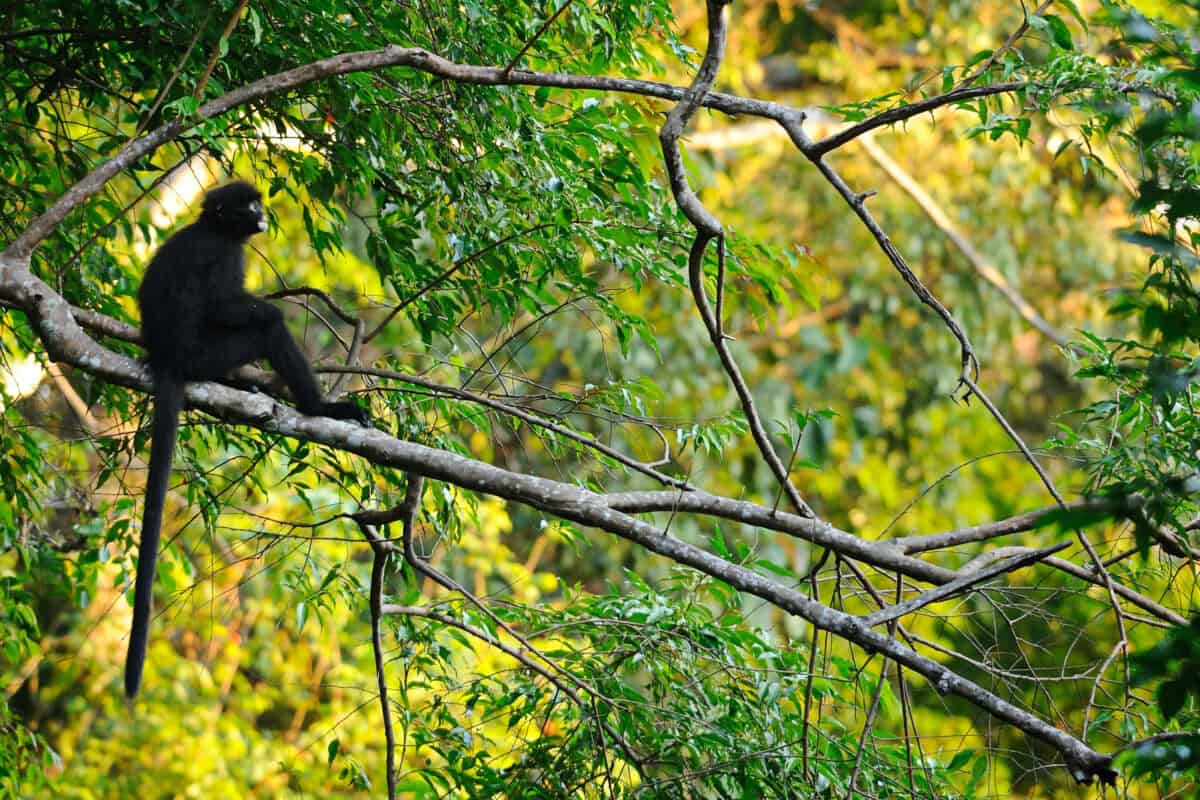
The reproductive biology of these fanged monkeys follows patterns typical of other leaf-eating primates but with some distinctive features. Unlike many primate species, banded leaf monkeys do not exhibit obvious visual signs of female fertility, such as sexual swellings. Females typically give birth to a single offspring after a gestation period of approximately 6-7 months. Newborns display a striking orange coat that gradually darkens to the adult coloration over the first few months of life—possibly an adaptation that signals infant status to other group members. Mothers provide intensive care for the first year, during which time the infant learns essential foraging skills and social behaviors. Young males typically leave their natal group upon reaching sexual maturity (around 4-5 years), while females may remain with their birth group throughout their lives. The impressive canines in males develop fully during puberty, coinciding with their preparation for competition over breeding opportunities.
Conservation Status and Threats
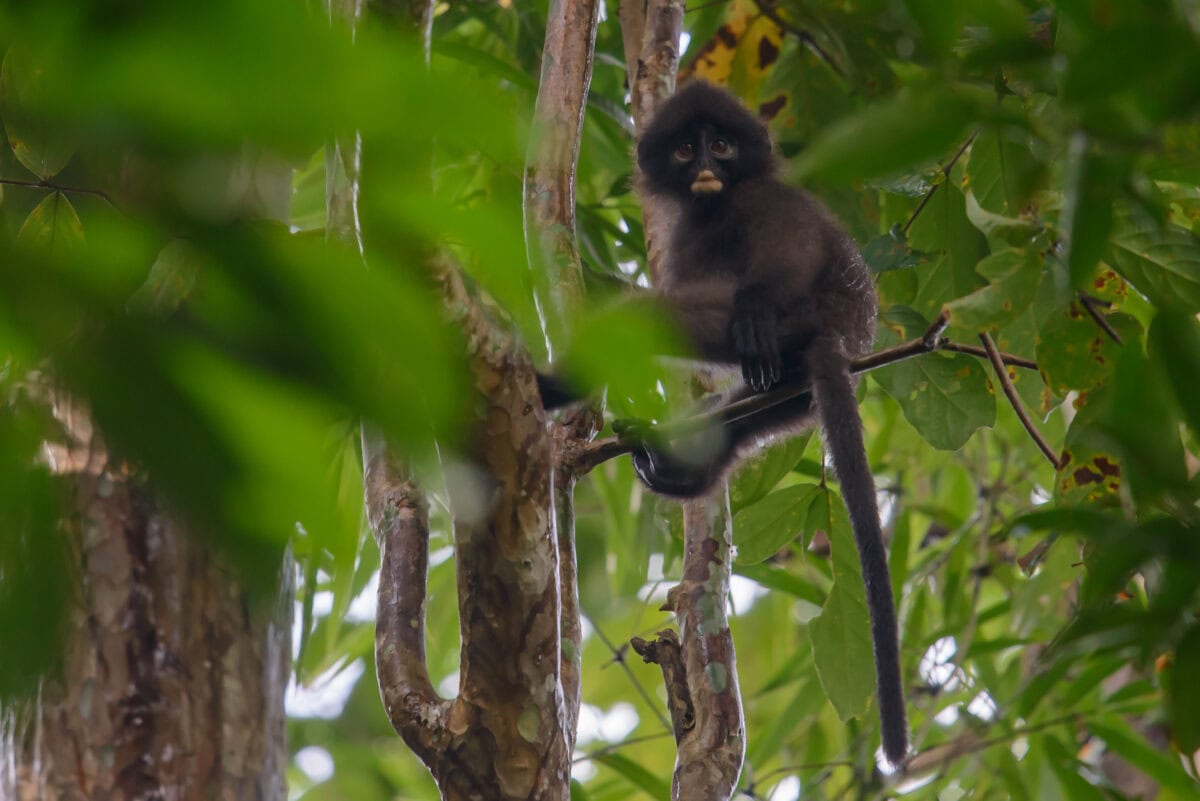
Despite their fearsome appearance, these fanged primates face far more threats than they pose. The banded leaf monkey is classified as Vulnerable on the IUCN Red List, with some subspecies in critical danger of extinction. The Singapore population, for example, is down to fewer than 60 individuals and restricted to a single forest reserve. Habitat loss represents the most significant threat, as agricultural expansion, logging, and urban development continue to fragment and diminish the rainforests they depend on. Their specialized leaf-eating diet makes them particularly vulnerable to forest disturbance, as they require mature, diverse forests that provide year-round food resources. Additionally, these monkeys face threats from hunting in some regions and the illegal wildlife trade. Conservation efforts focus on habitat protection, reforestation of wildlife corridors, and in some cases, captive breeding programs aimed at eventual reintroduction.
Scientific Research and Discoveries
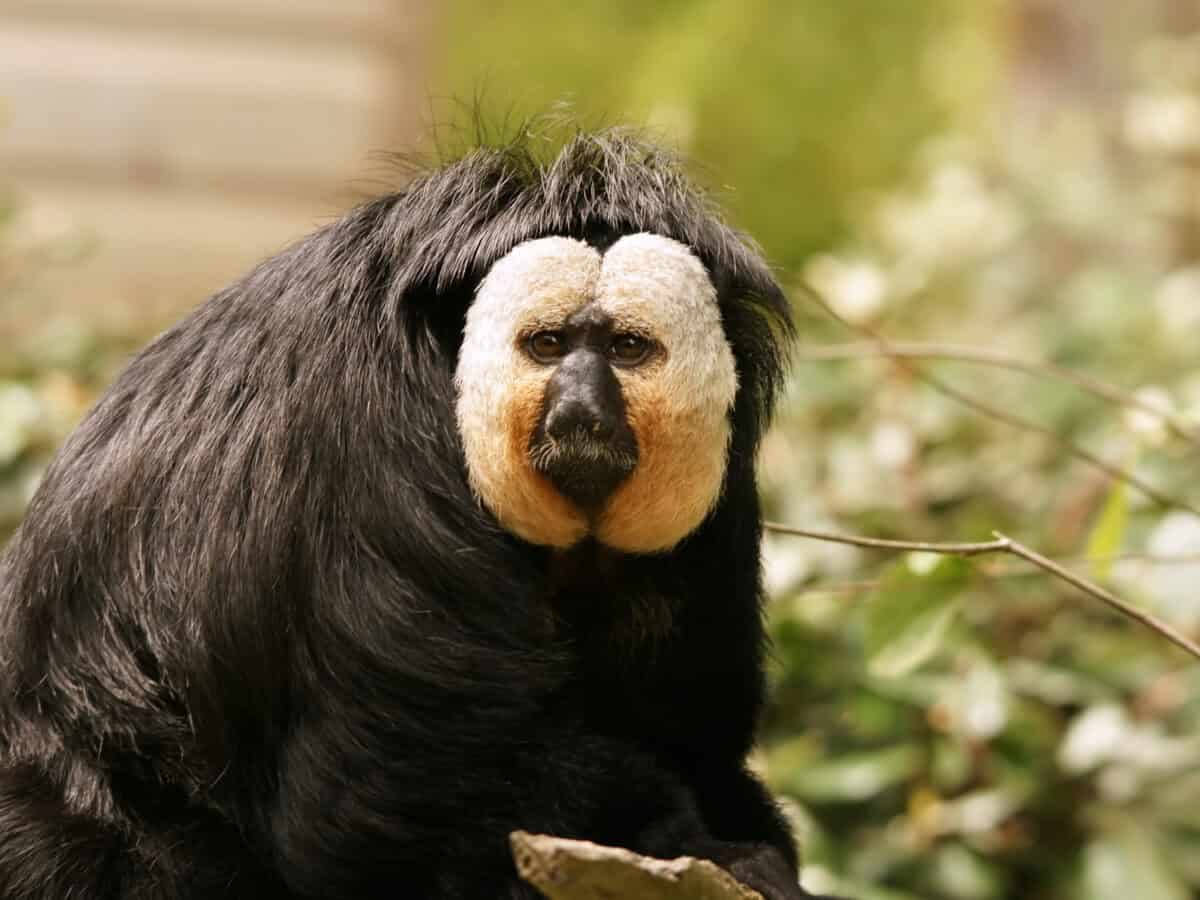
Scientific investigation into these vampire-fanged primates has yielded fascinating insights that extend beyond their striking dental features. Recent genetic studies have helped clarify taxonomic relationships, revealing that some populations previously considered subspecies may represent distinct species deserving their own conservation strategies. Research into their digestive physiology has uncovered specialized gut bacteria that help neutralize plant toxins and digest cellulose—findings with potential applications in biofuel production and pharmaceutical development. Field studies using modern tracking technologies have documented previously unknown aspects of their ranging patterns and habitat requirements, informing conservation planning. Perhaps most interestingly, dental morphology studies have demonstrated how their canine teeth reflect evolutionary compromises between feeding efficiency, social signaling, and predator deterrence. Despite these advances, significant knowledge gaps remain, particularly regarding their cognitive abilities, communication systems, and adaptability to changing environments.
Cultural Significance and Folklore

The striking appearance of these fanged primates has earned them a place in the folklore and cultural narratives of indigenous peoples throughout their range. In parts of Malaysia and Indonesia, local legends describe them as forest guardians with the power to ward off evil spirits. Their vampire-like teeth have inspired stories of supernatural transformation and nocturnal mischief, though these tales bear little resemblance to the animals’ actual diurnal and peaceful nature. In contemporary popular culture, these monkeys occasionally appear in viral social media posts that emphasize their unusual appearance, often accompanied by exaggerated claims about their behavior or diet. Wildlife photographers particularly prize images capturing their impressive dental display, contributing to their popularity in nature documentaries and wildlife publications. While their distinctive appearance can draw public attention to primate conservation, scientists and educators work to correct misperceptions that might portray these leaf-eaters as somehow dangerous or carnivorous.
Adaptations Beyond the Fangs
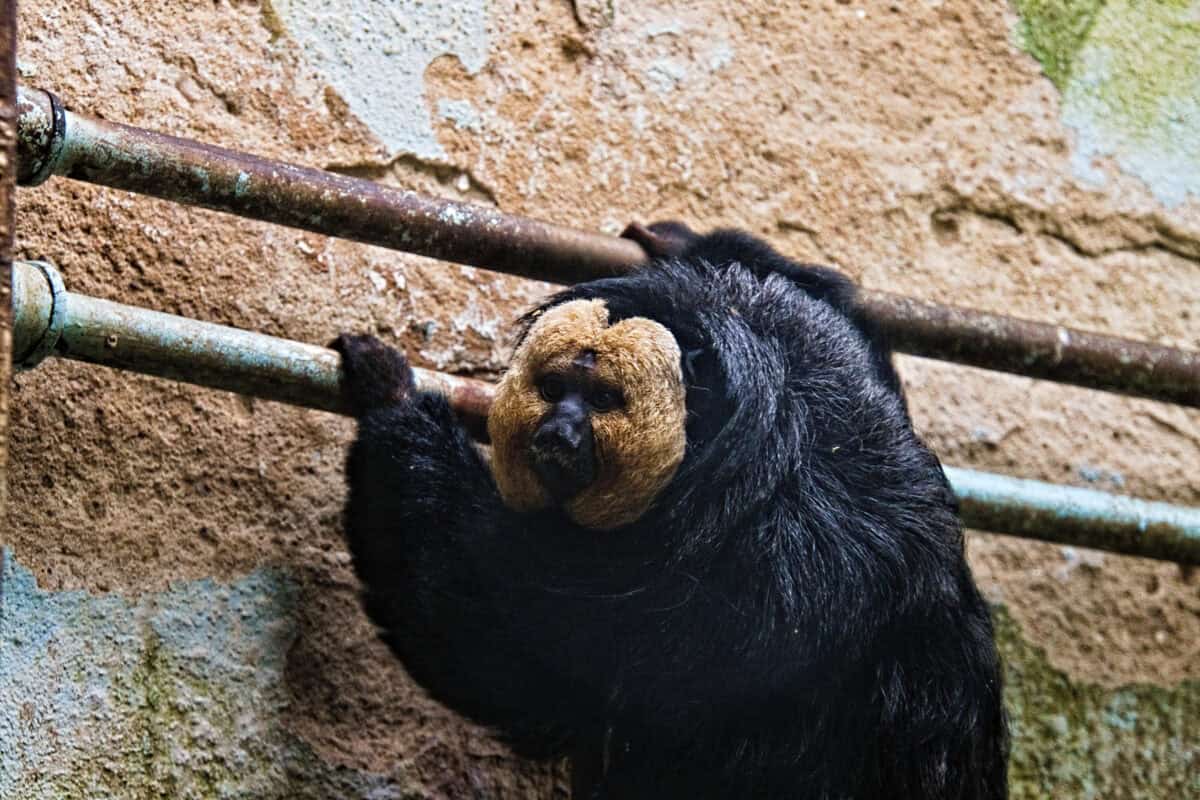
While their impressive canines attract the most attention, these primates possess numerous other adaptations that facilitate their specialized ecological niche. Their digestive systems feature enlarged, compartmentalized stomachs that house symbiotic bacteria capable of breaking down complex plant compounds and neutralizing defensive toxins. Their slender bodies and long limbs provide exceptional agility for moving through the forest canopy, where they travel using a combination of quadrupedal walking along branches and spectacular leaps across gaps. Many species display camouflaging coloration patterns that blend with dappled forest light, helping them avoid detection by predators such as clouded leopards and eagles. Their specialized vision, featuring excellent color discrimination, allows them to distinguish subtle differences in leaf maturity—a crucial skill for selecting the most nutritious and least toxic foliage. Some species also possess opposable thumbs and prehensile tails that provide additional grasping capabilities for their arboreal lifestyle.
Similar Species with Impressive Dentition
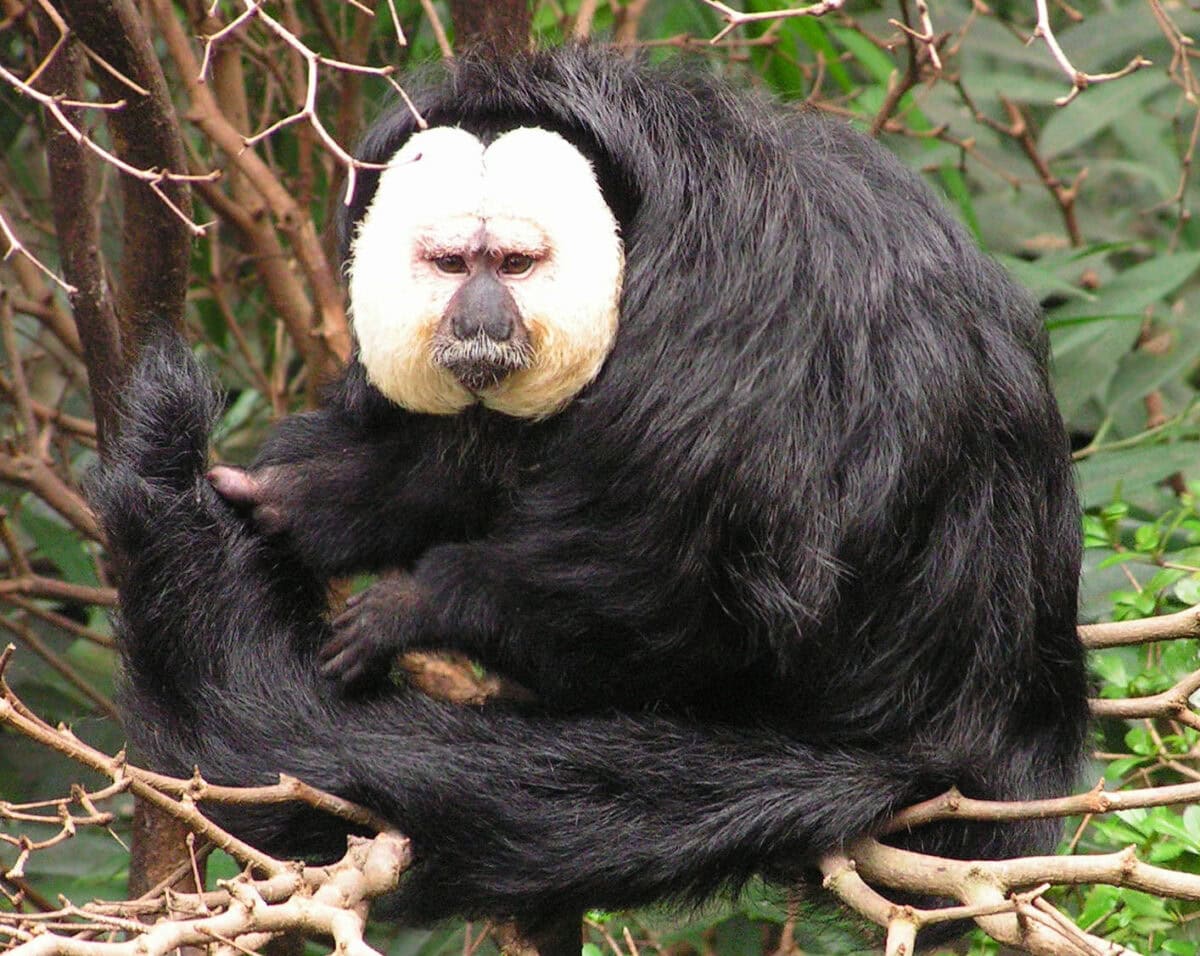
The vampire-like fangs of certain monkey species represent just one example of impressive primate dentition that has evolved for specific ecological and social purposes. The mandrill (Mandrillus sphinx), native to central Africa, displays similarly impressive canines that can reach over 2 inches in length in dominant males. Baboons also exhibit formidable canine teeth used primarily in dominance displays and predator defense. Among New World monkeys, the tufted capuchin (Sapajus apella) has developed remarkably strong teeth and jaws that allow it to crack open palm nuts and extract insects from tree bark. Perhaps the most extreme example comes from a different mammalian order entirely—the tusk deer or water deer of Asia, which possesses elongated canines resembling vampire fangs that can exceed 3 inches in length. These convergent evolutionary developments demonstrate how similar selective pressures can produce comparable anatomical features across different taxonomic groups, often serving similar social and ecological functions.
Conclusion: Beyond the Fearsome Facade
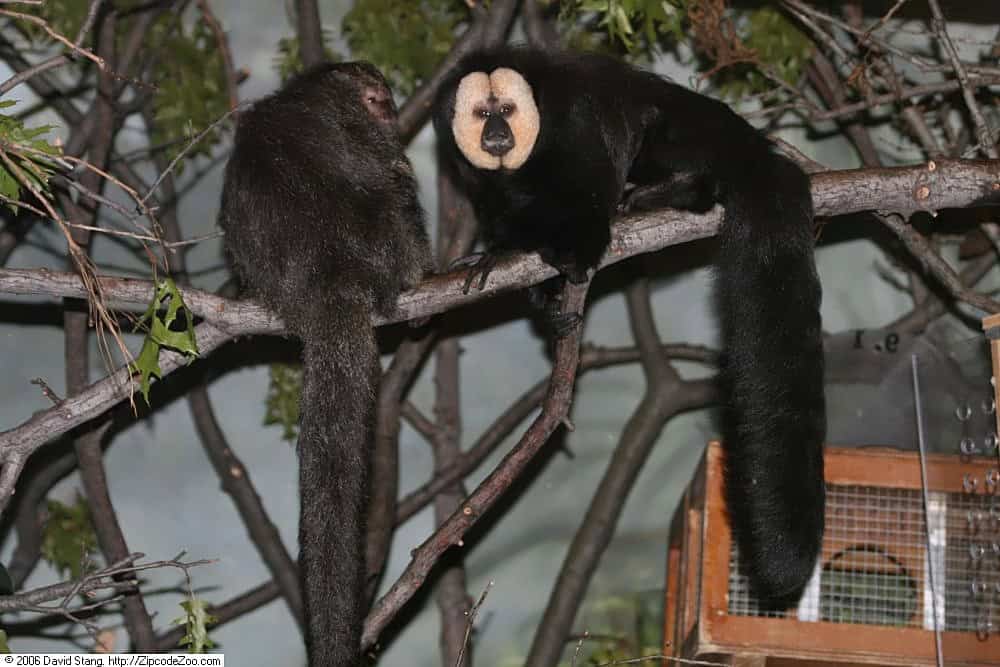
The vampire-fanged monkeys of Southeast Asia exemplify nature’s tendency to produce adaptations that may appear formidable but serve purposes far different from what human observers might initially assume. Behind their dramatic dental display lies a peaceful herbivore that has evolved specific traits to thrive in the complex ecological web of tropical rainforests. Their impressive canines tell a story not of bloodthirst but of evolutionary compromises between feeding efficiency, social communication, and reproductive success. As we continue to lose tropical forest habitat at alarming rates, these distinctive primates face an uncertain future, with some populations already teetering on the edge of extinction. Their preservation requires not only protected forest areas but also corridors that connect isolated populations and allow for genetic exchange. Perhaps the fascination these monkeys generate with their vampire-like appearance can serve as a gateway to broader public interest in primate conservation and the protection of the fragile forest ecosystems on which countless species depend.
- How Rhinos Communicate Using Dung and Urine - August 9, 2025
- Why Nurse Sharks Are Often Misunderstood - August 9, 2025
- 9 Most Venomous Spiders Lurking in US Homes - August 9, 2025

